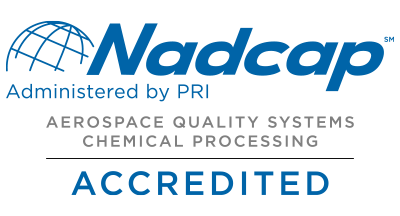Passivation of Stainless Steel at Anoplate
As an approved supplier of stainless steel passivation to many leading aerospace firms including, Hamilton Sundstrand, Honeywell, Lockheed Martin, Moog, Northrop Grumman, and others, Anoplate employs best practices when it comes to processing of your orders calling for passivate.
Corrosion Resistance of Stainless Steel
Passivation of stainless is essential in imparting optimum corrosion resistance performance in any part made from stainless steel. However certain alloys have an inherent risk for etching. The chances of etching happening are virtually nil for most austenitic grades of stainless (e.g. 301, 304, 316) and precipitation hardened stainless (e.g. 15-5PH, 17-4PH) while it is slightly higher for sulfur and selenium bearing free-machining austenitic grades such as 303 and 347. Knowing exactly what grade of stainless steel the parts are made from can direct the operator to use the properly formulated passivation solution to virtually eliminate the risk of attack in this regard. Anoplate has four different passivate baths for use depending on type of stainless and the specification called out.
This real risk for the potential of etching should not dissuade one from having the process performed, however, one should use processing houses familiar with the risk and those knowledgeable enough to take necessary precautions to minimize such risk.
In November 1986, the Macnohine and Tool BLUE BOOK published an article entitled “Passivating Stainless-Steel Parts” written by Terry DeBold, a metallurgist with Carpenter Technology. This article has been often cited by experts in the industry as the treatise on the subject of passivation. It includes many “dos and don’ts” for passivators that go beyond many of the specifications that direct the processor how to accomplish trouble-free passivation.
Passivation of 400-Series Stainless Steel
In passivating martensitic 400-series stainless steel, one of the suggestions to minimize the potential of catastrophic etching wherein all the parts are etched is to keep them electrically isolated by processing them on insulated racks or suspended by fish string rather than wire.
If they are touching one another by way of processing them in bulk in a basket or racked or wired onto a stainless steel fixture, if one part starts to etch it can cause the part next to it to likewise etch and this starts a chain reaction wherein the entire lot can become etched. While bulk processing is more economical, it can have its drawbacks and in cases where the alloy or parts have a history of etching, isolating the parts as shown in the photo may in the long run provide the necessary insurance.
For questions or more information on any of our finishes and custom coatings, or to get started on selecting the right finishes for your project Contact Us Today.
CONTACT US ONLINE (315) 471-6143
--
stainless steel passivation, corrosion resistance stainless steel, ASTM A967 passivation, AMS 2700 passivation, passivation process, stainless steel treatment, stainless steel corrosion prevention, passivation standards, metal finishing services, passivation chemicals, Anoplate














